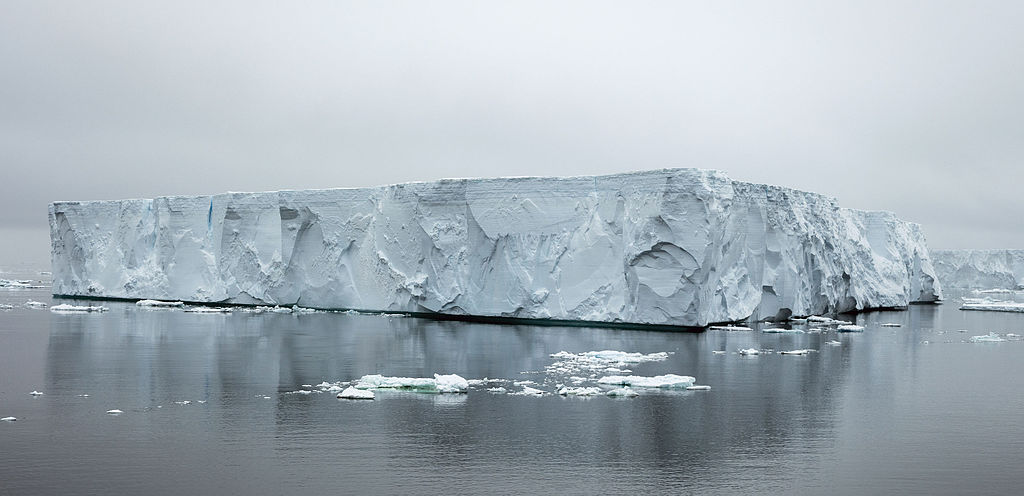Iceberg
An iceberg is a large piece of freshwater ice that has broken off a glacier or an ice shelf and is floating freely in open water. It may subsequently become frozen into pack ice (one form of sea ice). As it drifts into shallower waters, it may come into contact with the seabed, a process referred to as seabed gouging by ice. About 90% of an iceberg is below the surface of the water.
Etymology
The word "iceberg" is a partial loan translation from the Dutch word ijsberg, literally meaning "ice mountain", cognate to Danish isbjerg, German Eisberg, Low Saxon Iesbarg, and Swedish isberg.
Overview
Because the density of pure ice is about 920 kg/m3, and that of seawater about 1025 kg/m3, typically about one-tenth of the volume of an iceberg is above water (which follows from Archimedes's Principle of buoyancy). The shape of the underwater portion can be difficult to judge by looking at the portion above the surface. This has led to the expression "tip of the iceberg", for a problem or difficulty that is only a small manifestation of a larger problem.
The altitudes of the tips of icebergs typically range from 1 to 75 meters (3.3 to 246.1 ft) above sea level and weigh 100,000 to 200,000 metric tons (110,000 to 220,000 short tons). The largest known iceberg in the North Atlantic was 168 meters (551 ft) above sea level, reported by the USCG icebreaker East Wind in 1958, making it the height of a 55-story building. These icebergs originate from the glaciers of western Greenland and may have interior temperatures of −15 to −20 °C (5 to −4 °F).
Winds and currents tend to move icebergs close to the coast. The largest icebergs recorded have been calved, or broken off, from the Ross Ice Shelf of Antarctica. Iceberg B-15, photographed by satellite in 2000, measured 295 by 37 kilometers (183 by 23 mi), with a surface area of 11,000 square kilometers (4,200 sq mi). The largest iceberg on record was an Antarctic tabular iceberg of over 31,000 square kilometers (12,000 sq mi) [335 by 97 kilometers (208 by 60 mi)] sighted 150 miles (240 km) west of Scott Island, in the South Pacific Ocean, by the USS Glacier on November 12, 1956. This iceberg was larger than Belgium.
As a piece of iceberg ice melts, it produces a fizzing sound called the "Bergie Seltzer". This sound results when the water-ice interface reaches compressed air bubbles trapped in the ice. As this happens, each bubble bursts, making a 'popping' sound. The bubbles contain air trapped in snow layers very early in the history of the ice, that eventually got buried to a given depth (up to several kilometers) and pressurized as it transformed into firn then to glacial ice.
Recent large icebergs
- Iceberg B-15 11,000 km2 (4,200 sq mi), 2000
- Iceberg A-38, about 6,900 km2 (2,700 sq mi), 1998
- Iceberg A-68, (Larsen C) 5,800 km2 (2,200 sq mi), 2017
- Iceberg C-19, 5,500 km2 (2,100 sq mi), 2002
- Iceberg B-22, 5,490 km2 (2,120 sq mi), 2002
- Iceberg B-9, 5,390 km2 (2,080 sq mi), 1987
- Iceberg B-15A, 3,100 km2 (1,200 sq mi), broke off 2003
- Iceberg B-31, 615 km2 (237 sq mi), 2014
- Iceberg D-16, 310 km2 (120 sq mi), 2006
Ice sheet, 260 km2 (100 sq mi), broken off of Petermann Glacier in northern Greenland on August 5, 2010, considered to be the largest Arctic iceberg since 1962.[9] About a month later, this iceberg split into two pieces upon crashing into Joe Island in the Nares Strait next to Greenland.[10] In June 2011, large fragments of the Petermann Ice Islands were observed off the Labrador coast.[11] Iceberg B-17B 140 km2 (54 sq mi), 1999, shipping alert issued December 2009.[12]
Shape
In addition to size classification, icebergs can be classified on the basis of their shape. The two basic types of iceberg forms are tabular and non-tabular. Tabular icebergs have steep sides and a flat top, much like a plateau, with a length-to-height ratio of more than 5:1. This type of iceberg, also known as an ice island, can be quite large, as in the case of Pobeda Ice Island. Antarctic icebergs formed by breaking off from an ice shelf, such as the Ross Ice Shelf or Filchner-Ronne Ice Shelf, are typically tabular. The largest icebergs in the world are formed this way.
Non-tabular icebergs have different shapes and include:
- Dome: An iceberg with a rounded top.
- Pinnacle: An iceberg with one or more spires.
- Wedge: An iceberg with a steep edge on one side and a slope on the opposite side.
- Dry-Dock: An iceberg that has eroded to form a slot or channel.
- Blocky: An iceberg with steep, vertical sides and a flat top. It differs from tabular icebergs in that its aspect ratio, the ratio between its width and height, is small, more like that of a block than a flat sheet.
Monitoring
Icebergs are monitored worldwide by the U.S. National Ice Center (NIC), established in 1995, which produces analyses and forecasts of Arctic, Antarctic, Great Lakes and Chesapeake Bay ice conditions. More than 95% of the data used in its sea ice analyses are derived from the remote sensors on polar-orbiting satellites that survey these remote regions of the Earth.
The NIC is the only organization that names and tracks all Antarctic Icebergs. It assigns each iceberg larger than 10 nautical miles (19 km) along at least one axis a name composed of a letter indicating its point of origin and a running number. The letters used are as follows:
- A – longitude 0° to 90° W (Bellingshausen Sea, Weddell Sea)
- B – longitude 90° W to 180° (Amundsen Sea, Eastern Ross Sea)
- C – longitude 90° E to 180° (Western Ross Sea, Wilkes Land)
- D – longitude 0° to 90° E (Amery Ice Shelf, Eastern Weddell Sea)
Iceberg B15 calved from the Ross Ice Shelf in 2000 and initially had an area of 11,000 square kilometers (4,200 sq mi). It broke apart in November 2002. The largest remaining piece of it, Iceberg B-15A, with an area of 3,000 square kilometers (1,200 sq mi), was still the largest iceberg on Earth until it ran aground and split into several pieces October 27, 2005, an event that was observed by seismographs both on the iceberg and across Antarctica. It has been hypothesized that this breakup may also have been abetted by ocean swell generated by an Alaskan storm 6 days earlier and 13,500 kilometers (8,400 mi) away.

